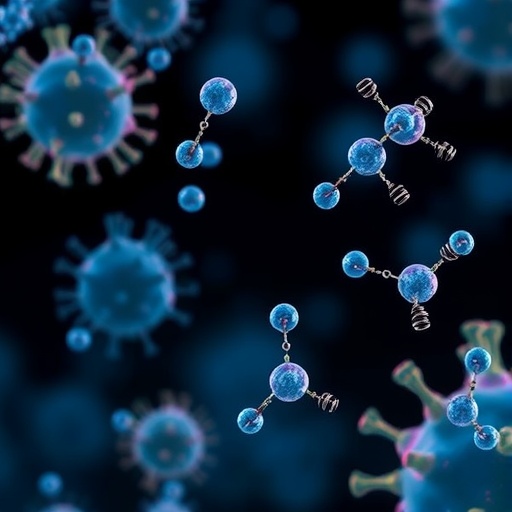In the relentless arms race between bacteria and the viruses that infect them, known as bacteriophages or phages, bacteria have evolved a myriad of defense systems. Among these, the Panoptes system has emerged as an intriguing molecular sentinel. Recent research published in Nature illuminates a novel interplay between phage-encoded proteins and this bacterial defense, unveiling a surprising mechanism whereby phages not only evade but are paradoxically dependent on viral proteins to trigger the bacterial immune response.
Phage T4, a model virus widely studied for its infection of Escherichia coli, typically produces irregular plaques when tested against strains expressing the OptSE operon, a key part of the Panoptes defense mechanism. Yet at elevated phage concentrations, researchers observed the emergence of unusually large, clear plaques, indicative of phage “escapers” capable of bypassing bacterial defense. These escapers were isolated from three independent clonal T4 populations and subjected to genome sequencing.
The genomic landscape of these escaper phages revealed a striking pattern: 14 of the 15 variants harbored mutations exclusively in the phage gene acb2, also known as anti-CBASS 2. This gene encodes a protein previously characterized as an “anti-defense” factor that functions by binding cyclic oligonucleotides—small signaling molecules crucial for the activation of CBASS (cyclic oligonucleotide-based antiphage signaling systems). Mutations ranged from insertions and deletions to frameshifts and premature stop codons that effectively inactivated acb2.
These findings were counterintuitive. Normally, mutations that enable phages to escape bacterial immunity enhance the function or binding affinity of phage proteins antagonistic to defense systems. Instead, the mutations crippled Acb2, suggesting that contrary to previous understanding, Acb2 is not merely an antagonist but a necessary element for activation of the Panoptes-mediated defense.
To test this hypothesis, scientists challenged E. coli strains expressing the OptSE operon with either wild-type T4 or T4 lacking acb2 (T4∆acb2). Whereas wild-type T4 was effectively restricted by the bacterial defense, the T4∆acb2 phage replicated robustly, evading detection. This demonstrated that without Acb2, the Panoptes system fails to mount an immune response, underscoring the protein’s essential role as a trigger rather than a suppressor.
Further investigations revealed the specificity of this effect. Phage T4 harbors another anti-CBASS factor, acb1, a phosphodiesterase that degrades cyclic oligonucleotide signals. However, deleting acb1 had no significant impact on the effectiveness of Panoptes-mediated defense. Even when both acb1 and acb2 were deleted, the phenotype mirrored the acb2 single knockout, highlighting that acb2 is uniquely critical in the activation process.
Mechanistic insights came from biophysical analyses showing that Acb2 binds cyclic dinucleotides such as 2′,3′-c-di-AMP with high affinity. This sequestration of cyclic nucleotide signals was previously thought to suppress downstream immune activation by preventing effector proteins from sensing these molecules. However, the new data argue for an alternate model where Acb2 binding serves as a decoy mechanism, engaging the Panoptes machinery and precipitating bacterial defense responses.
Moreover, the interplay between Acb2 and the Panoptes operon was probed by co-expressing various gene components from the operon alongside Acb2 variants. Bacterial colony formation assays showed that the presence of functional Acb2 in the background of an intact OptSE operon severely restricted growth, confirming that Acb2 is sufficient to activate Panoptes defense signaling. In contrast, catalytically dead versions of the operon’s key effector, OptS, abrogated this defensive phenotype.
Fluorescence microscopy further illustrated the cellular consequences of this interaction. Upon induction of Acb2 expression in bacteria also expressing the OptSE operon, cells exhibited rapid membrane perturbations and uptake of propidium iodide—a dye indicating compromised membrane integrity—within 30 minutes. These changes intensified over the course of 90 minutes, signifying cell death triggered by the activated defense system.
Collectively, these results reveal a sophisticated bacterial immunity tactic whereby the phage’s own anti-defense protein inadvertently acts as a molecular key to unlock the Panoptes antiviral response. Unlike classical evasion strategies, the phage protein Acb2 serves as both a necessary activator and a target for bacterial defense, representing a nuanced co-evolutionary strategy.
These discoveries not only deepen our comprehension of bacterial-phage dynamics but also pave the way for biotechnological exploitation. Understanding the molecular triggers of bacterial immunity can inform the design of novel antimicrobial agents and synthetic biology frameworks, potentially harnessing phage proteins as switches to modulate bacterial signaling.
This research also prompts a reconsideration of the functional roles of viral anti-defense factors. Rather than acting solely as inhibitors, such proteins may participate in complex signaling cascades that paradoxically enhance host defense under certain contexts. This duality exemplifies the intricate molecular dialogue forged over billions of years of microbial conflict.
In summary, the study uncovers a novel facet of the Panoptes defense system in E. coli, whereby the phage-encoded Acb2 protein is indispensable not for suppression but for activation of immune responses. This finding challenges the conventional narrative of viral counter-defense mechanisms and invites further exploration into the molecular choreography between pathogens and their hosts.
Future research directions include structural characterization of the Acb2-Panoptes interaction, elucidation of downstream signaling pathways activated by this molecular decoy, and exploration of analogous systems in other bacterial species. Such endeavors will continue to reveal the evolutionary ingenuity etched into microbial genomes and may unlock new strategies for combating antibiotic-resistant infections through phage therapy and immune modulation.
Subject of Research: Bacterial immune defense mechanisms and phage interaction, specifically the Panoptes system and the role of phage-encoded anti-CBASS protein Acb2 in activating bacterial immunity.
Article Title: The Panoptes system uses decoy cyclic nucleotides to defend against phage.
Article References:
Sullivan, A.E., Nabhani, A., Izrailevsky, D.S. et al. The Panoptes system uses decoy cyclic nucleotides to defend against phage. Nature (2025). https://doi.org/10.1038/s41586-025-09557-z
Image Credits: AI Generated




